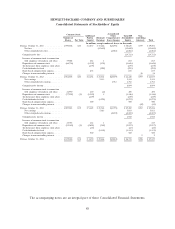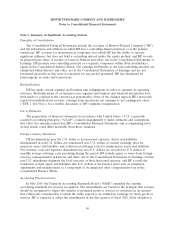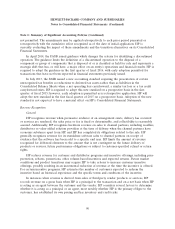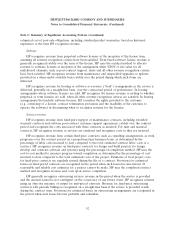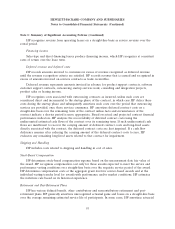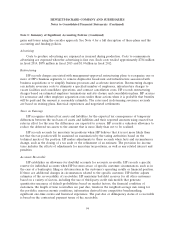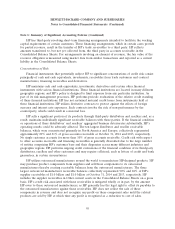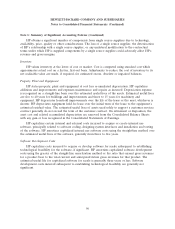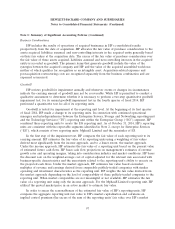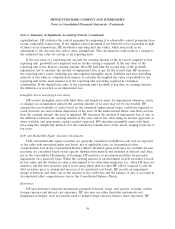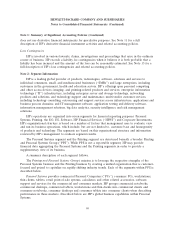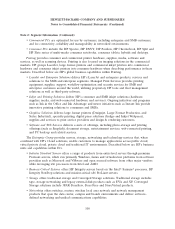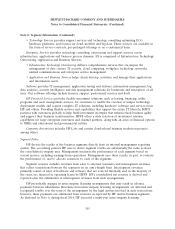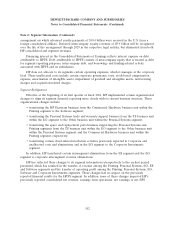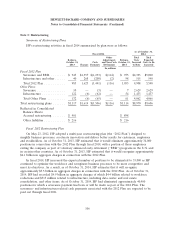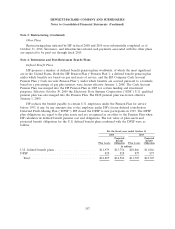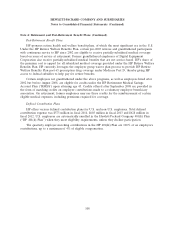HP 2014 Annual Report Download - page 106
Download and view the complete annual report
Please find page 106 of the 2014 HP annual report below. You can navigate through the pages in the report by either clicking on the pages listed below, or by using the keyword search tool below to find specific information within the annual report.HEWLETT-PACKARD COMPANY AND SUBSIDIARIES
Notes to Consolidated Financial Statements (Continued)
Note 1: Summary of Significant Accounting Policies (Continued)
capitalization). HP evaluates the control premium by comparing it to observable control premiums from
recent comparable transactions. If the implied control premium is not believed to be reasonable in light
of these recent transactions, HP reevaluates reporting unit fair values, which may result in an
adjustment to the discount rate and/or other assumptions. This reevaluation could result in a change to
the estimated fair value for certain or all reporting units.
If the fair value of a reporting unit exceeds the carrying amount of the net assets assigned to that
reporting unit, goodwill is not impaired and no further testing is required. If the fair value of the
reporting unit is less than its carrying amount, then HP performs the second step of the goodwill
impairment test to measure the amount of impairment loss, if any. In the second step, HP measures
the reporting unit’s assets, including any unrecognized intangible assets, liabilities and non-controlling
interests at fair value in a hypothetical analysis to calculate the implied fair value of goodwill for the
reporting unit in the same manner as if the reporting unit was being acquired in a business
combination. If the implied fair value of the reporting unit’s goodwill is less than its carrying amount,
the difference is recorded as an impairment loss.
Intangible Assets and Long-Lived Assets
HP reviews intangible assets with finite lives and long-lived assets for impairment whenever events
or changes in circumstances indicate the carrying amount of an asset may not be recoverable. HP
assesses the recoverability of assets based on the estimated undiscounted future cash flows expected to
result from the use and eventual disposition of the asset. If the undiscounted future cash flows are less
than the carrying amount, the asset is impaired. HP measures the amount of impairment loss, if any, as
the difference between the carrying amount of the asset and its fair value using an income approach or,
when available and appropriate, using a market approach. HP amortizes intangible assets with finite
lives using the straight-line method over the estimated economic lives of the assets, ranging from one to
ten years.
Debt and Marketable Equity Securities Investments
Debt and marketable equity securities are generally considered available-for-sale and are reported
at fair value with unrealized gains and losses, net of applicable taxes, in Accumulated other
comprehensive loss in the Consolidated Balance Sheets. Realized gains and losses for available-for-sale
securities are calculated based on the specific identification method and included in Interest and other,
net in the Consolidated Statements of Earnings. HP monitors its investment portfolio for potential
impairment on a quarterly basis. When the carrying amount of an investment in debt securities exceeds
its fair value and the decline in value is determined to be other-than-temporary (i.e., when HP does not
intend to sell the debt securities and it is not more likely than not that HP will be required to sell the
debt securities prior to anticipated recovery of its amortized cost basis), HP records an impairment
charge to Interest and other, net in the amount of the credit loss and the balance, if any, is recorded in
Accumulated other comprehensive loss in the Consolidated Balance Sheets.
Derivatives
HP uses derivative financial instruments, primarily forwards, swaps, and options, to hedge certain
foreign currency and interest rate exposures. HP also may use other derivative instruments not
designated as hedges, such as forwards used to hedge foreign currency balance sheet exposures. HP
98


